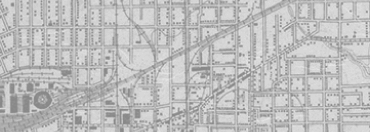


Back
Kodak Brownie 8mm movie camera
Kodak 8mm Brownie movie camera used by Dallas mail carrier F.M. "Mark" Bell to film the Kennedy motorcade and the aftermath of the assassination. Bell worked in the U.S. Terminal Annex building on the south side of Dealey Plaza. On November 22, 1963, he brought his recently purchased single-lens Kodak Brownie 8 camera to work, promising his daughter that, since Bell would not allow her to miss school that day, he would take a home movie of President Kennedy for her.
Kodak Brownie 8mm movie camera
11/22/1963
Metal, Glass, Plastic
5 × 2 1/2 × 6 1/4 in. (12.7 × 6.4 × 15.9 cm)
Mark Bell Collection/The Sixth Floor Museum at Dealey Plaza
2021.036.0002
F.M. "Mark" Bell (1918-1998) was a Dallas mail carrier who worked in the U.S. Terminal Annex building on the south side of Dealey Plaza and had a walking route that covered the downtown commercial area. On November 22, 1963, Bell brought his recently purchased single-lens Kodak Brownie 8 camera to work, promising his daughter that, since Bell would not allow her to miss school that day, he would take a home movie of President Kennedy for her. While on his lunch break, Bell positioned himself at the northwest corner of Main and Houston streets, standing on a cement peristyle that elevated him about four feet above the crowd. From that vantage, he took approximately fifteen seconds of footage of the motorcade on Main Street approaching Houston and then traveling up Houston Street towards Elm Street. During the Houston Street sequence, President and Mrs. Kennedy noticeably drop out of frame at times. This is the result of Bell holding the camera beside his face rather than looking through the viewfinder. Bell next filmed a short sequence showing the presidential limousine turning from Houston to Elm and passing the front entrance of the Texas School Book Depository building. He stopped filming once a tree obstructed his view. At that point, Bell jumped down from his position and was moving to the end of the north peristyle when he heard shots fired at the motorcade. Bell recalled in 1967 that he heard a total of three shots, two of which sounded close together. Immediately after the assassination, Bell began filming again, capturing a series of aftermath sequences in Dealey Plaza. After a shaky, blurred pan, Bell’s film shows the limousine traveling beneath the Triple Underpass and overtaking the lead car in the parade with the Secret Service follow-up vehicle close behind. The film next shows the grassy knoll area on the north side of Elm Street. Several well-known assassination eyewitnesses are seen, including Jean Hill and Mary Moorman, the Newman family and the controversial "Babushka Lady," whose identity remains in dispute. A growing number of people soon appear on the south side of Elm, looking towards the grassy knoll. In perhaps the most dramatic sequence, numerous bystanders hurriedly cross Elm Street and run up the grassy knoll towards the stockade fence. Bell filmed a couple of additional sequences as he left the area, showing crowds of people clustered together along Elm Street and slow-moving traffic at a near standstill. Without speaking to anyone, Bell made his way back to the Terminal Annex to resume his workday, pausing long enough to film the Texas School Book Depository building and the activity in Dealey Plaza from an upper story window. Bell never spoke with any law enforcement officials and quietly had his film developed the following week. The Bell film did not receive public notice or research attention until 1967 when Bell apparently mentioned the film to Dallas journalist Patsy Swank, a stringer for Life Magazine. That same year, Bell was interviewed by researcher Josiah Thompson, who was working as a consultant with Life. The Bell film was featured in a story about amateur photographers in Dealey Plaza entitled, "Last Seconds of the Motorcade," published in the November 24, 1967, issue of Life. Josiah Thompson also published five frames from the Bell film in his 1967 book, Six Seconds in Dallas, writing that the frames had never been seen before. The Bell film was subsequently borrowed and evaluated by the House Select Committee on Assassinations in the late 1970s. Although it does not capture any of the assassination and only fleeting glimpses of President and Mrs. Kennedy, the Bell film provides one of the best views of the presidential limousine passing beneath the Triple Underpass, and it dramatically documents the post-assassination activity in Dealey Plaza. For researchers, in addition to the brief appearance of the "Babushka Lady" along Elm Street, the most important aspect of the Bell film is that it demonstrates that many bystanders rushed up the grassy knoll immediately following the assassination, suggesting at least the possibility of a second gunman in that location. -- Stephen Fagin, Curator
Mark Bell's Kodak 8mm Brownie was one of a dozen home movie cameras added to a permanent installation, "The Photographers and the Evidence," at The Sixth Floor Museum in November 1996. It remains on display as of 2022. -- Stephen Fagin, Curator
Kodak Brownie 8mm movie camera
Kodak 8mm Brownie movie camera used by Dallas mail carrier F.M. "Mark" Bell to film the Kennedy motorcade and the aftermath of the assassination. Bell worked in the U.S. Terminal Annex building on the south side of Dealey Plaza. On November 22, 1963, he brought his recently purchased single-lens Kodak Brownie 8 camera to work, promising his daughter that, since Bell would not allow her to miss school that day, he would take a home movie of President Kennedy for her.
Kodak Brownie 8mm movie camera
11/22/1963
Motorcade
Assassination
Films
Home movie
Cameras
Eyewitnesses
Bell, Mark
Kodak
Dallas
Metal, Glass, Plastic
5 × 2 1/2 × 6 1/4 in. (12.7 × 6.4 × 15.9 cm)
Mark Bell Collection/The Sixth Floor Museum at Dealey Plaza
2021.036.0002
F.M. "Mark" Bell (1918-1998) was a Dallas mail carrier who worked in the U.S. Terminal Annex building on the south side of Dealey Plaza and had a walking route that covered the downtown commercial area. On November 22, 1963, Bell brought his recently purchased single-lens Kodak Brownie 8 camera to work, promising his daughter that, since Bell would not allow her to miss school that day, he would take a home movie of President Kennedy for her. While on his lunch break, Bell positioned himself at the northwest corner of Main and Houston streets, standing on a cement peristyle that elevated him about four feet above the crowd. From that vantage, he took approximately fifteen seconds of footage of the motorcade on Main Street approaching Houston and then traveling up Houston Street towards Elm Street. During the Houston Street sequence, President and Mrs. Kennedy noticeably drop out of frame at times. This is the result of Bell holding the camera beside his face rather than looking through the viewfinder. Bell next filmed a short sequence showing the presidential limousine turning from Houston to Elm and passing the front entrance of the Texas School Book Depository building. He stopped filming once a tree obstructed his view. At that point, Bell jumped down from his position and was moving to the end of the north peristyle when he heard shots fired at the motorcade. Bell recalled in 1967 that he heard a total of three shots, two of which sounded close together. Immediately after the assassination, Bell began filming again, capturing a series of aftermath sequences in Dealey Plaza. After a shaky, blurred pan, Bell’s film shows the limousine traveling beneath the Triple Underpass and overtaking the lead car in the parade with the Secret Service follow-up vehicle close behind. The film next shows the grassy knoll area on the north side of Elm Street. Several well-known assassination eyewitnesses are seen, including Jean Hill and Mary Moorman, the Newman family and the controversial "Babushka Lady," whose identity remains in dispute. A growing number of people soon appear on the south side of Elm, looking towards the grassy knoll. In perhaps the most dramatic sequence, numerous bystanders hurriedly cross Elm Street and run up the grassy knoll towards the stockade fence. Bell filmed a couple of additional sequences as he left the area, showing crowds of people clustered together along Elm Street and slow-moving traffic at a near standstill. Without speaking to anyone, Bell made his way back to the Terminal Annex to resume his workday, pausing long enough to film the Texas School Book Depository building and the activity in Dealey Plaza from an upper story window. Bell never spoke with any law enforcement officials and quietly had his film developed the following week. The Bell film did not receive public notice or research attention until 1967 when Bell apparently mentioned the film to Dallas journalist Patsy Swank, a stringer for Life Magazine. That same year, Bell was interviewed by researcher Josiah Thompson, who was working as a consultant with Life. The Bell film was featured in a story about amateur photographers in Dealey Plaza entitled, "Last Seconds of the Motorcade," published in the November 24, 1967, issue of Life. Josiah Thompson also published five frames from the Bell film in his 1967 book, Six Seconds in Dallas, writing that the frames had never been seen before. The Bell film was subsequently borrowed and evaluated by the House Select Committee on Assassinations in the late 1970s. Although it does not capture any of the assassination and only fleeting glimpses of President and Mrs. Kennedy, the Bell film provides one of the best views of the presidential limousine passing beneath the Triple Underpass, and it dramatically documents the post-assassination activity in Dealey Plaza. For researchers, in addition to the brief appearance of the "Babushka Lady" along Elm Street, the most important aspect of the Bell film is that it demonstrates that many bystanders rushed up the grassy knoll immediately following the assassination, suggesting at least the possibility of a second gunman in that location. -- Stephen Fagin, Curator
Mark Bell's Kodak 8mm Brownie was one of a dozen home movie cameras added to a permanent installation, "The Photographers and the Evidence," at The Sixth Floor Museum in November 1996. It remains on display as of 2022. -- Stephen Fagin, Curator










